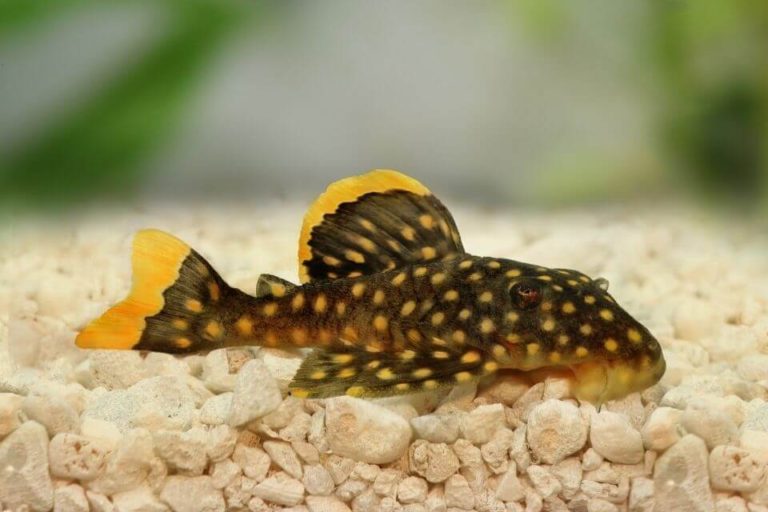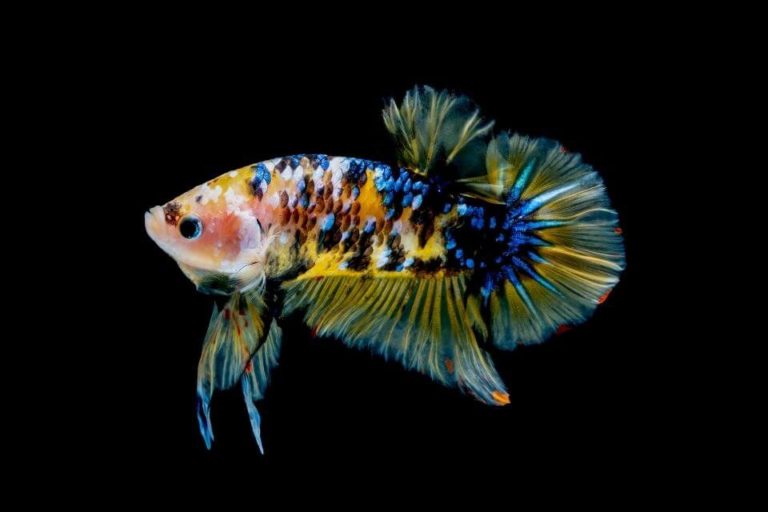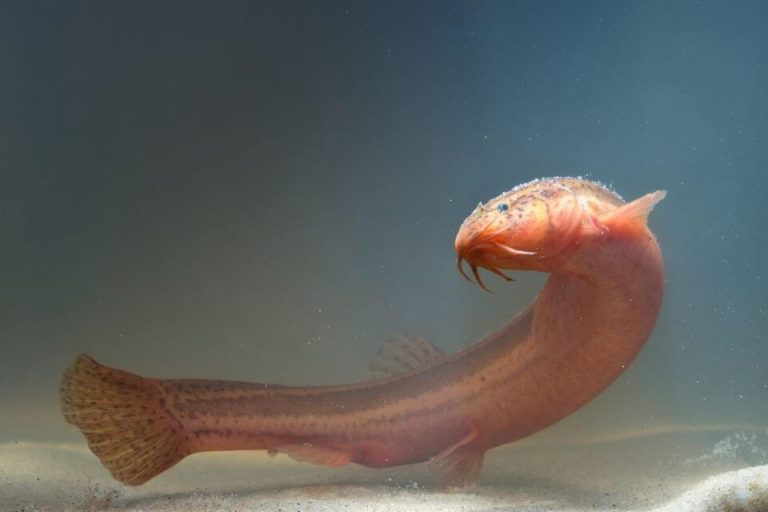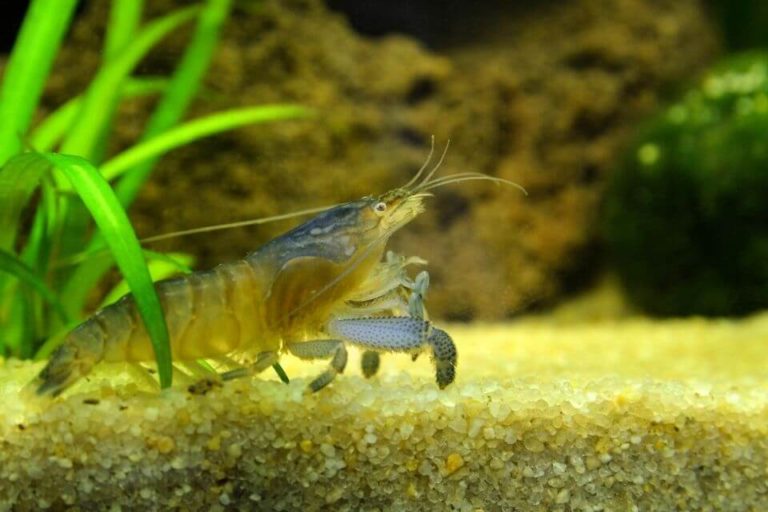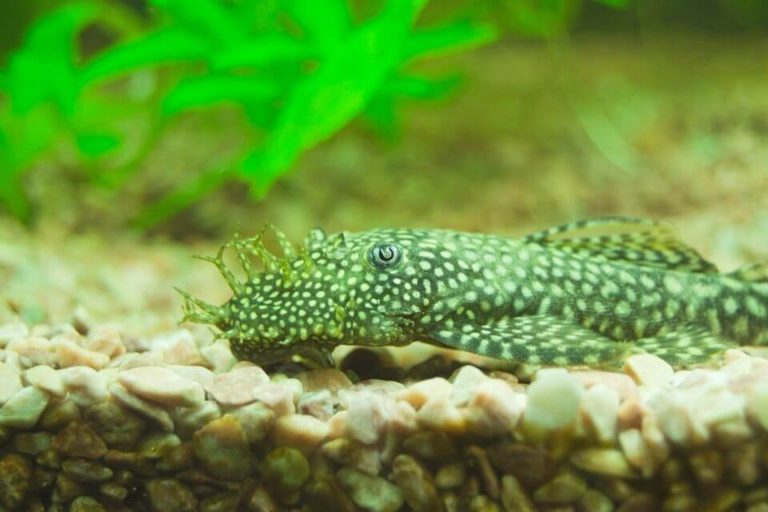Blue Dolphin Cichlid Care: Lifespan, Size, Food and Tank Mates

Blue Dolphin Cichlid is a beautiful Cichlid fish species that can be found in the aquarium hobby and mostly spent its time in the bottom part of the tank.
These freshwater fish will enhance the appearance of your underwater space. In this Blue Dolphin Cichlid care article, we will provide you with all the information you need to keep these fish healthy and happy in your tank!
| Quick Facts: | |
|---|---|
| Common Names | Blue Dolphin Cichlid, Malawi Blue Dolphin |
| Origin | Lake Malawi, East Africa |
| Family | Cichlidae |
| Scientific Name | Cyrtocara moorii |
| Care Level | Easy to medium |
| Temperament | Less aggressive |
| Social | Community friendly |
| Diet | Omnivore |
| Size (average) | Up to 10 inches (in captivity) |
| Lifespan | 7 to 10 years |
| Breeding | Egg layer |
| Minimum Tank Size | 100 gallons |
| Tank Setup | Freshwater, sandy or smooth gravel substrate, including driftwood, rock, clay pots, and caves for hiding places. Avoid bright lights. Use plants with strong roots. |
| Tank Temperature | 76 – 82 °F (24 – 28 °C) |
| Water Hardness | 8 - 12 dGH |
| Water pH Level | 7.0 - 9.0 |
Species Overview
The Blue Dolphin Cichlid (Cyrtocara moorii) is a freshwater fish that originates from the lakes of East Africa, precisely Malawi. It is also called Malawi Blue Dolphin and is a member of the Cichlidae family, which contains over 1500 species of fish.
In general, these Cichlid species are less aggressive compared to other members of this fish family. The Blue Dolphin Cichlid gets its name from its blue coloration and dolphin-like shape.
The Blue Dolphin Cichlid is an omnivore and in the wild, it feeds on small crustaceans, insects, and plants. In captivity, they should be fed a diet that consists of high-quality dry and frozen foods, as well as live foods.
It has a pointed head with large eyes, and its body is elongated and compressed. The Blue Dolphin Cichlid is a popular fish among aquarium hobbyists because of its beautiful coloration.
Blue Dolphin Cichlid Size
The full-grown Blue Dolphin Cichlid size is around 10 inches long in a captivity environment. They are large cichlid and can reach up to 20 inches long in the wild.
The males are larger than the females and have longer fins. Besides, their size can also differ depending on the availability of food and space. Because of the size of this fish, it can be kept in a minimum of 100 gallons tank.
Blue Dolphin Cichlid Lifespan
The average Blue Dolphin Cichlid lifespan is around 7 to 10 years in aquarium conditions. However, under special care, they can live up to 15 years.
How long they live will be determined by their diet, housing, and the level of care they receive. You might find them live longer than 15 years in their wild habitats because they are getting natural touch in the wild.
Behavior & Temperament
Malawi Blue Dolphin Cichlid is a semi-aggressive cichlid that is best kept with other semi-aggressive to aggressive cichlids. They are not recommended for a community tank unless all the fish are of a similar size.
They are best kept in pairs or harem groups consisting of one male and two to three females. Malawi Blue Dolphin is a mouth-brooder, which means the female will hold the eggs in her mouth until they hatch.
Additionally, the Cyrtocara moorii has a unique feature where they can change their color depending on their mood or environment. When they are happy and comfortable, they will be a beautiful blue color.
However, when they are stressed or threatened, they will turn a drab gray color. Since this fish is a predator, it is not recommended to keep them with smaller fish.
Appearance And Coloration
The Blue Dolphin Cichlid is a beautiful fish that gets its name from its blue and yellow coloration. They are easily recognizable and are one of the most popular cichlid species.
They seem peaceful fish but can be aggressive towards other Blue Dolphin Cichlids. Malawi Blue Dolphin is large with a stocky, oval body.
They can grow up to 15 inches in length and are one of the largest cichlid species. Their pointed snouts resemble that of a dolphin, hence their name. Their tailfins are rounded and their dorsal fins are long and pointed.
Both sexes have these features, but the males tend to be larger and more brightly colored. They have a deep blue color with varying shades of blue on their fins and body. The males are usually more brightly colored than the females.
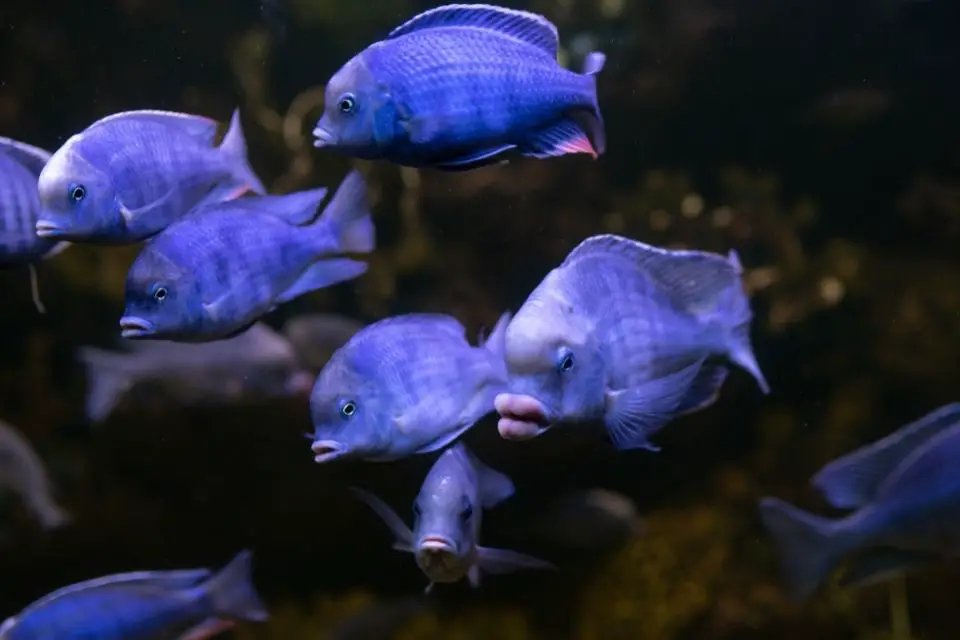
The base color of the Blue Dolphin Cichlid is light blue with electric blue highlights. They have yellow spots on their body and fins. The juveniles are darker in color and do not have the bright colors of the adults.
Blue Dolphin Cichlid Care
The species is not difficult to care for and does best in a well-oxygenated aquarium with a sandy substrate. They are relatively peaceful fish but can be territorial towards their own species and other cichlids.
The species is quite hardy and can tolerate a wide range of water conditions as well as a varied diet. When it comes to their health and disease the species is quite resistant to most diseases that affect freshwater fish.
The biggest threat to their health is poor water quality so it’s important to keep up with your water changes.
– Blue Dolphin Cichlid Tank Size
The Blue Dolphin Cichlid is relatively large, reaching lengths of up to 10 inches (25 cm) in a fish tank. As such, they will require a tank of at least 100 gallons.
A 100 gallons tank would be even better to provide these fish with plenty of room to swim and explore. Fish in a larger aquarium tend to be much healthier and have a longer lifespan than those in smaller tanks.
In a small tank, the fish tend to be more stressed which can lead to health problems.
– Blue Dolphin Cichlid Tank Setup
The ideal tank setup for a Blue Dolphin Cichlid includes plenty of open swimming space as well as some hiding places. Your tank setup should include:
-Substrate:
A sandy substrate is best, as Blue Dolphin Cichlids like to sift through the sand looking for food. The substrate can be mixed with some larger soft rocks to create hiding places.
In the wild, the substrate is often murky and stirred up, so don’t be afraid to have a little bit of debris in your aquarium.
-Lighting:
A dim light is best, as bright light can cause stress. Moreover, Blue Dolphin Cichlids come from murky waters, so they are not used to bright light. Additionally, the lighting should not be too harsh as it can cause the colors of the fish to fade.
-Water filter:
A water filter is necessary to keep the water clean and the tank healthy. The ideal filtration system for a Blue Dolphin Cichlid tank is a canister filter with a medium flow rate.
This allows for plenty of water movement while still providing enough filtration to keep the water clean.
-Decorations:
Blue Dolphin Cichlids like to have plenty of hiding places, so be sure to include rocks, caves, driftwood, and other decorations in your tank. Live plants can also be used to decorate your fish tank.
Make sure to choose plants that can tolerate the high water temperatures and pH levels required by Blue Dolphin Cichlids. Additionally, the decorations should be securely placed so that they cannot be overturned by the fish.
Some of the decorations you can opt for are:
Rocks: Choose rocks that are smooth and have no sharp edges. The rocks should be large enough that the fish cannot easily overturn them.
Caves: Caves can be made of rocks, driftwood, or other materials. Be sure that the cave is large enough for the fish to swim into and turn around comfortably.
Driftwood: Driftwood can provide both hiding places and a place for the fish to rest. Be sure to choose driftwood that is safe for aquarium use and has no sharp edges.
Aquarium Plants: The best plants for a Blue Dolphin Cichlid aquarium are those that can provide the fish with plenty of hiding places.
- Java Fern
- Anubias
- African Water Fern
These plants are also relatively tough and can withstand the heavy digging that cichlids are known for.
– Water Parameters And Testing
The Blue Dolphin Cichlid is a freshwater fish that originates from the waters of Lake Malawi in Africa. The water should, therefore, mimic the natural habitat as much as possible.
Acidity Level: The pH level should be between 7 and 9. This species prefers alkaline water. To maintain these levels, you can use driftwood, rocks, and plants that naturally lower the pH level. To test for pH levels, use a reliable test kit.
Ammonia, Nitrite, and Nitrate: These levels should all be at 0 ppm. If they are not, you can use a water conditioner to remove them.
Hardness: The hardness of the water should be between 8 and 12 dGH. This is a measure of the dissolved minerals in the water.
Temperature: The temperature should be between 76 and 82 degrees Fahrenheit. These are the temperatures that are found in their natural habitat. To test for these water parameters, you can use a reliable test kit.
Water Temperature: 76 - 82 degrees Fahrenheit Acidity Level: 7 - 9 pH Hardness: 8 - 12 dGH
– Blue Dolphin Cichlid Diet And Feeding
The Blue Dolphin Cichlid is an omnivore and in the wild, it will eat pretty much anything that it can find. In the aquarium, you should provide a varied diet that includes both meaty and vegetable foods.
A good quality commercial cichlid pellet or flakes can form the basis of the diet but should be supplemented with live, frozen, or freeze-dried foods such as bloodworms, brine shrimp, and daphnia.
You can also offer blanched vegetables such as zucchini, broccoli, and spinach. Be sure to feed small meals several times a day rather than one large meal.
By the rule of thumb, you should only feed an amount that your fish can consume in under five minutes. Typically, feed your Cichlid after every twelve hours
– Common Diseases And Prevention
One of the most common diseases that Blue Dolphin Cichlids suffer from is a hole-in-the-head disease. This disease is caused by a parasite that attacks the fish’s skin, causing lesions and eventually leading to holes in the head.
The best way to prevent this disease is to maintain clean water conditions and to treat the fish with a medication that is specifically designed for hole-in-the-head disease.
White spot disease:
This disease is caused by a parasitic organism that enters the fish through open wounds. The parasite then multiplies and causes white spots on the fish’s body.
To prevent white spot disease, it is important to quarantine new fish before adding them to your main tank. This will allow you to treat the new fish for any parasites or diseases they may have.
Malawi Bloat:
This is a common disease that affects cichlids from Lake Malawi. It is caused by protozoans in its stomach and can be deadly if not treated immediately.
The disease manifests in form of symptoms including a bloated abdomen, lethargy, loss of appetite, and increased mucus production. Treatment includes the use of Metronidazole which can be found in most pet stores.
Cotton Wool Disease:
Cotton wool disease is a common fungal infection that can affect fish of all ages. It is characterized by white cotton-like growths on the skin, fins, and gills. If left untreated, the cotton wool disease can be fatal.
To prevent cotton wool disease, it is important to maintain clean water conditions and to quarantine new fish before adding them to your tank. If you do notice any signs of the disease, treat your fish with suitable anti-fungal medication.
Gill Flukes:
Gill flukes are parasitic flatworms that attach themselves to the gills of fish. They cause irritation and inflammation, making it difficult for the fish to breathe. Gill flukes can be treated with copper-based medications.
To prevent gill flukes, quarantine new fish for at least four weeks before adding them to your tank.
Cichlid Granuloma:
Cichlid granuloma is a growth on the skin or fins of fish. It is caused by bacteria and can be treated with antibiotics. This disease is more common in fish that are stressed or have a weak immune system.
To prevent cichlid granuloma, make sure your fish are well-fed and have a clean and stress-free environment.
Difference Between Blue Dolphin Cichlid Male Vs Female
To distinguish between a Blue Dolphin Cichlid male and a female, you need to look at the size and shape of their genital papilla. The male’s genital papilla is much longer and narrower than the female’s.
Another way to sex Blue Dolphin Cichlids is by looking at their coloration. The males are much more brightly colored than the females. The female Blue Dolphin Cichlids tend to be a duller gray color.
Aside from that, the males also have more blue coloration on their fins. Another possibility to help determine the sex of your Blue Dolphin Cichlid is its behavior.
The males are much more aggressive than the females and will often chase the females around. The males will also build nests and defend them vigorously.
The best way to determine the sex of your Blue Dolphin Cichlid is by looking at its genital papilla. If you can’t tell by looking at that, then their behavior is usually a good indicator.
Blue Dolphin Cichlid Breeding
Malawi Blue Dolphins can be bred in pairs or harem groups. A single male can be kept with several females. If you choose to keep a harem group, it is recommended that you have at least four females for every male.
This will help to reduce aggression between the fish.
The species Cyrtocara moorii is not difficult to breed in the home aquarium. They are mouthbrooders, which means that the female will incubate the eggs in her mouth until they hatch.
The females lay around 20 eggs at a time puts them into their mouths and then get to the male’s anal fin. The male will then fertilize the eggs. The eggs hatch after about 21 days and the fry is free-swimming after another week.
The couple participates in the spawning process. The fry grows quickly and can be fed on brine shrimp nauplii, daphnia, or finely ground flake food. The fry can be difficult to raise if the water quality is not maintained.
It is recommended to do small water changes often and to remove any uneaten food after each feeding. The water requirements for breeding are pH 7.5 to 9.0, hardness dGH 12 to 18, and a temperature of 79 to 84°F (26-29°C).
The best way to achieve these conditions is to use reverse osmosis or deionized water and then add the appropriate amount of marine salt mix.
The female carries the eggs in her mouth for these 21 days and will not eat for the entire time. It tends to get weak and lose color. After hatching the fry are free-swimming, the parents will eat them if given the chance.
It is best to move the parents to another tank or aquarium after spawning is complete.
Blue Dolphin Cichlid Tank Mates
The ideal tank mates for Malawi Blue Dolphins are other Haplochromine cichlids of a similar size. These fish share many similarities with Cyrtocara moorii and are therefore well-suited to life in the same tank.
Other potential tank mates include:
Origin And Distribution
Malawi Blue Dolphin Cichlid is a freshwater fish that is found in Lake Malawi. It is also known as the Blue Dolphin Cichlid, Malawi Blue Dolphin, Haplochromis moorii, and Turquoise Cichlid.
The natural habitat of the Malawi Blue Dolphin Cichlid is in rocky areas with plenty of hiding places. The species has been widely distributed and can be found in aquariums all over the world.
Other regions where the fish is found include Tanzania, Mozambique, and the Comoro Islands.
FAQs
Are Blue Dolphin Cichlids Aggressive?
Yes, the Blue Dolphin Cichlid is less aggressive. They are known to be particularly aggressive towards other cichlid species.
If you are keeping them with other fish, it is best to do your research beforehand to make sure that the species are compatible.
How Many Blue Dolphin Cichlids Should Be Kept Together?
Blue Dolphin Cichlids are social creatures and should be kept in pairs or small groups. A single fish will likely become stressed and may become aggressive towards other tank mates.
Typically, a ratio of one male to two females is ideal. A 200 gallons tank can hold about 5 to 6 fish.
How Big Do Blue Dolphin Cichlids Get?
The average size of a Blue Dolphin Cichlid is around 10 inches in aquarium settings. However, some have been known to grow up to 15 inches. They are a relatively large cichlid, so they will need a spacious tank.
A 100 gallons aquarium is a minimum size you should consider for a pair of Blue Dolphin Cichlids (male and female). But 120 gallons are highly recommended when are they fully grown.
How Fast Do Blue Dolphin Cichlids Grow?
Blue Dolphin Cichlids are a fast-growing species. In the wild, they can grow up to 20 inches long. In captivity, they typically reach about half that size which is 10 inches.
They can live for up to 15 years with proper care. In about 2 years, they can grow from fry to full-grown adults.
What Is Albino Blue Dolphin Cichlid?
Albino Blue Dolphin Cichlid is the albino form of the Blue Dolphin Cichlid and a beautiful fish that is popular among aquarium enthusiasts. The Albino Blue Dolphin Cichlid gets its name from its body color with white fins.
Albino Blue Dolphin Cichlid is a less aggressive community fish that can be kept with other peaceful fish. It is an omnivore fish and is relatively easy to care for and can live up to 10 years in captivity.
How Often Do Dolphin Cichlids Breed?
Dolphin Cichlids typically breed every two to three months. However, if the conditions are right, they can breed easily. Breeders often use hormone treatment to induce spawning.
Additionally, breeding pairs often need to be separated from the rest of the school during the breeding process.
Are Dolphin Cichlids Mouth Brooders?
Dolphin cichlids are mouthbrooders, which means that the female will carry the eggs and the fry in her mouth until they are ready to be released into the world.
This provides a high level of care and protection for the young, but it also means that the female needs to be in good health and condition to be able to successfully mouth the brood.
How Much Do Blue Dolphin Cichlids Cost?
The cost of a Blue Dolphin Cichlid can vary depending on the size and color of the fish. A juvenile Blue Dolphin Cichlid will cost around $15, while an adult fish can cost up to $30.
You can buy the fish from most pet stores that sell tropical fish and also might be available online at reasonable prices. The only challenge is to find reliable breeders online.
Final Thoughts
Overall, the Blue Dolphin Cichlid is a beautiful and hardy fish that is a great addition to any freshwater aquarium. They are relatively easy to care for but do require a bit of space to swim and plenty of hiding places.
These fish are also known to be quite peaceful, making them a good choice for community tanks. With proper care, your Blue Dolphin Cichlid can live for several years in your aquarium.
If you’re looking for a stunning fish that is relatively easy to care for, the Blue Dolphin Cichlid is a great choice!
Just be sure to provide them with plenty of space to swim and plenty of hiding places, and you’ll have a happy and healthy fish for years to come. Thanks for reading!


